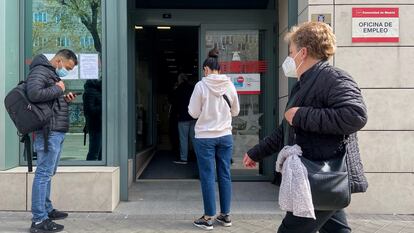Spain’s labor market adds 134,396 jobs in April despite continuing effects of pandemic
There were 39,012 fewer people without employment, although the tourism sector is still shedding workers

Although the effects of the coronavirus pandemic continue to be felt in the Spanish labor market, the latest figures offered by the Labor and Social Security ministries are affording some relief.
Spain’s unemployment figure decreased by 39,012 individuals between the end of March and the end of April, for a total of 3,910,628 people currently registered as jobless. Meanwhile, the Social Security system added 134,396 new contributors over the same period, to reach an average of 19,055,298.
The labor market improved in April thanks to job creation in construction, agriculture, fishing and the livestock industry. The tourism sector, on the other hand, continued to shed jobs.
April is traditionally a good month for employment in Spain, partly because of seasonal factors such as the arrival of warm weather and the Easter vacations that kick off the tourism season. But the coronavirus pandemic has affected two Easters in a row now, undermining the stimulus to the hospitality industry. Whereas April 2017 set a new record for monthly drops in unemployment, in April 2021, there were 79,425 more jobless people in Spain than a year earlier – despite the fact that in April 2020, everyone was confined in their homes due to the coronavirus lockdown.

The figures also offer a clear picture of the gender gap: women account for 57.8% of Spain’s unemployed population. Broken down by regions, the highest jobless numbers are to be found in Andalusia (984,497), Catalonia (497,185) and the Valencia region (447,650). Despite this, Catalonia experienced the second-biggest drop in monthly unemployment (-8,715), after the Basque Country (-3,039).
Although 1,356,845 new contracts were signed in April, it was still 47,262 fewer than in March. Additionally, 87.9% of these were temporary contracts, reflecting a longstanding structural problem with the Spanish job market.
Despite ongoing restrictions on mobility that are hurting tourism, some measures have been eased – including longer opening hours for bars and restaurants – and this has provided some relief to struggling businesses. Help has also come in the form of the government’s ERTE job retention scheme, although the latest extension to this program is due to expire on May 31.
According to Social Security figures released on Wednesday, there were 638,238 people on the ERTE program on April 29, representing a drop of 36,621 from the end of March. The scheme has saved thousands of businesses from going under during the pandemic, but some companies are already transitioning to collective layoffs (EREs) that could affect as many as 35,000 workers in the banking, retail and auto sectors.
Determining the exact number of jobless people in Spain is difficult: furloughed workers on the ERTE scheme are not being counted as unemployed, and the two ministries offer different figures. This is because the Labor Ministry relies on a voluntary register where people seeking a job of under 20 hours a week or a contract of less than three months are not considered unemployed. The other key indicator, the EPA workforce survey, uses a different methodology and counts as jobless any individual who has not worked a single hour on the week of the survey despite actively wanting to. According to EPA figures, there was an average of 3.6 million people without a job in the first quarter of the year, for an unemployment rate of 15.98%.
English version by Susana Urra.
Tu suscripción se está usando en otro dispositivo
¿Quieres añadir otro usuario a tu suscripción?
Si continúas leyendo en este dispositivo, no se podrá leer en el otro.
FlechaTu suscripción se está usando en otro dispositivo y solo puedes acceder a EL PAÍS desde un dispositivo a la vez.
Si quieres compartir tu cuenta, cambia tu suscripción a la modalidad Premium, así podrás añadir otro usuario. Cada uno accederá con su propia cuenta de email, lo que os permitirá personalizar vuestra experiencia en EL PAÍS.
¿Tienes una suscripción de empresa? Accede aquí para contratar más cuentas.
En el caso de no saber quién está usando tu cuenta, te recomendamos cambiar tu contraseña aquí.
Si decides continuar compartiendo tu cuenta, este mensaje se mostrará en tu dispositivo y en el de la otra persona que está usando tu cuenta de forma indefinida, afectando a tu experiencia de lectura. Puedes consultar aquí los términos y condiciones de la suscripción digital.
More information
Últimas noticias
Most viewed
- Sinaloa Cartel war is taking its toll on Los Chapitos
- Reinhard Genzel, Nobel laureate in physics: ‘One-minute videos will never give you the truth’
- Oona Chaplin: ‘I told James Cameron that I was living in a treehouse and starting a permaculture project with a friend’
- Why the price of coffee has skyrocketed: from Brazilian plantations to specialty coffee houses
- David King, chemist: ‘There are scientists studying how to cool the planet; nobody should stop these experiments from happening’











































